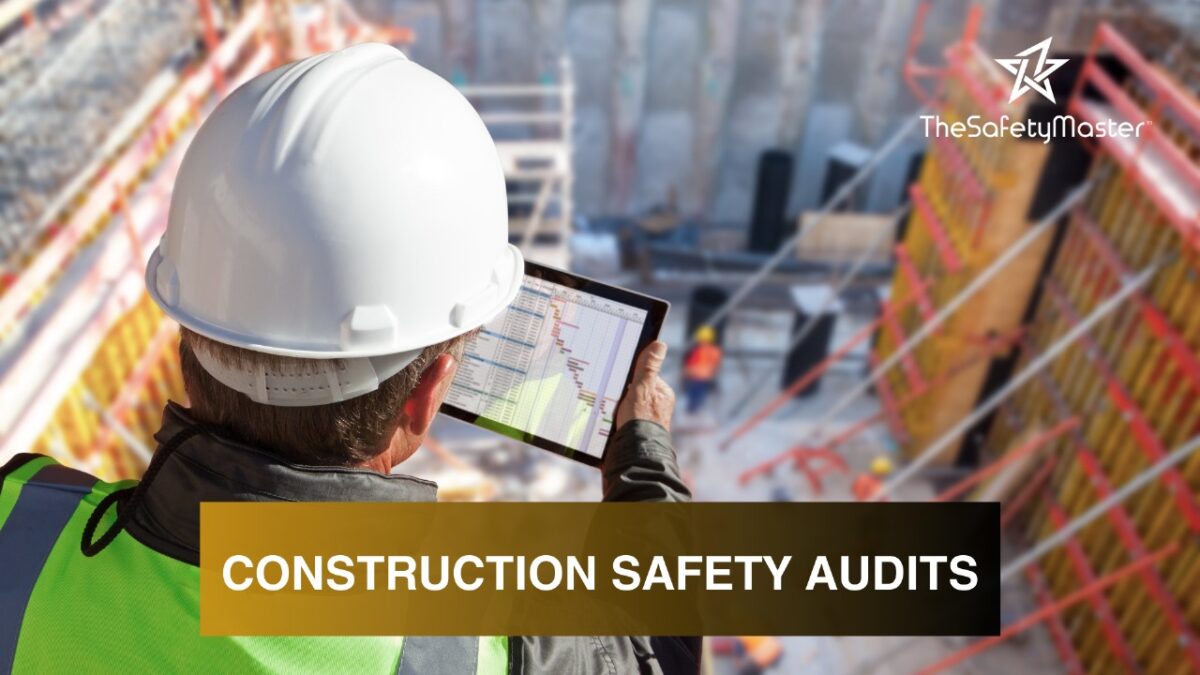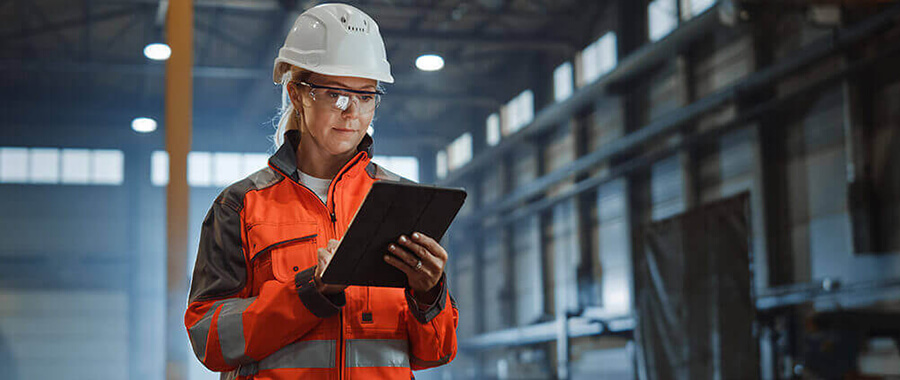The Importance of Construction Safety Audits: Ensuring a Secure Working Environment for Employees

Scaffolding Safety Training: A Proactive Approach Towards Employee Protection in Indian Industries
October 26, 2023
The Key Steps for Successful Safety Management System Implementation in High-Risk Industries
October 26, 2023In this article, we delve into a critical aspect that cannot be overlooked in any construction project: the importance of construction safety audits. Ensuring a secure working environment for employees should be a top priority for every construction company. Unfortunately, accidents and injuries on construction sites still occur far too frequently. That’s why implementing effective safety audits is crucial. By the end of this article, you will have a clear understanding of why safety audits are necessary, what to expect during the audit process, and most importantly, how prioritizing construction safety audits can safeguard the well-being of your employees. Stay tuned for expert insights and valuable tips that promise to enhance workplace safety in the construction industry. Let’s create a safer working environment together.
Introduction
Construction sites are bustling with activity, as workers diligently strive to build towering structures that shape our surroundings. Yet, amidst the noise and progress, there is an inherent danger that lurks within this industry – the risk of accidents and injuries. The importance of construction safety audits cannot be overstated, as they play a pivotal role in ensuring a secure working environment for employees. In this article, we will delve into the world of construction safety audits and explore their significance in preventing accidents and promoting a culture of safety within the industry. We will examine how these audits assess potential hazards, identify non-compliance with safety regulations, and help implement effective policies and procedures. By the end of this journey, you will gain a deeper understanding of why construction safety audits are vital for safeguarding workers’ well-being
Understanding Construction Safety Audits
Understanding Construction Safety Audits: In the realm of construction, where every step counts, safety audits play a pivotal role in ensuring the well-being of workers and creating a secure working environment. Construction safety audits are comprehensive assessments conducted to identify and mitigate potential hazards, assess compliance with safety regulations, and implement effective measures to prevent accidents. These audits involve thorough inspections of construction sites, equipment, processes, and employee practices to evaluate their adherence to established safety protocols.
The primary objective of a construction safety audit is to foster a culture of proactive risk management. By understanding the importance of audits in this context, we recognize their power to prevent accidents before they occur. They provide an opportunity for employers and employees alike to gain insights into potential hazards and take swift action towards mitigating them. Through these audits, companies can demonstrate their commitment to prioritizing worker welfare while enhancing overall productivity and efficiency within the industry.
The Role of Safety Audits in Preventing Accidents
The Role of Safety Audits in Preventing Accidents: Safety audits play a pivotal role in safeguarding construction workers from potential accidents and hazards that can occur on job sites. By conducting thorough inspections and assessments, safety audits help identify potential risks and address them proactively. These audits involve a comprehensive evaluation of the work environment, equipment, tools, and practices employed by the construction team.
Through safety audits, construction companies can ensure that their employees have access to a secure working environment where risks are minimized. These audits serve as an opportunity to review safety procedures and protocols, ensuring compliance with industry standards and regulations. By identifying areas that require improvement or modification, safety audits enable swift action to be taken to rectify shortcomings.
Furthermore, safety audits empower organizations to implement effective preventive measures that reduce the likelihood of accidents occurring in the first place. This proactive approach not only saves lives but also minimizes disruption to project timelines. By prioritizing worker safety through regular safety audits, construction companies instil confidence in their employees and cultivate a positive work culture cantered around well-being.
Remember: A secure work environment is not just about fulfilling legal obligations; it is about genuinely caring for the welfare of your workers. Prioritizing safety through comprehensive safety audits ensures that all employees return home safely at the end of each day – a result that benefits everyone involved and contributes to the overall success of any construction project.
Assessing Potential Hazards and Risks
Assessing Potential Hazards and Risks: As construction sites are dynamic environments, it becomes crucial to conduct thorough assessments of potential hazards and risks. By meticulously scrutinizing the surroundings, we can identify lurking dangers that may compromise the safety of construction workers. From uneven terrain to faulty equipment, each element must be examined with a discerning eye to ensure that all risks are mitigated. This process not only safeguards the well-being of employees but also demonstrates a commitment to their welfare that instils confidence and boosts morale within the workforce.
Delving into every nook and cranny of a construction site unveils an array of potential hazards. These could include electrical wiring in close proximity to water sources, slippery surfaces due to spills or inclement weather conditions, or inadequate protective gear provided to workers. By closely examining such risks, construction safety audits serve as a proactive measure in preventing accidents before they occur. This approach not only fosters trust among employees but also positions the company as a leader in prioritizing worker safety – fostering loyalty from both clients and staff alike.
Furthermore, assessing potential hazards and risks allows for targeted strategies in eliminating or reducing their impact on workers’ well-being. Installing proper signage warning against specific dangers, implementing clear protocols for handling hazardous materials, or introducing engineering controls like fall protection systems all contribute towards creating a secure working environment. Through meticulous analysis and effective action plans derived from safety audits, companies can demonstrate their unwavering commitment to employee safety while simultaneously setting higher industry standards for others to follow – paving the way for an enlightened construction sector that values human life above all else.
Identifying Non-Compliance with Safety Regulations
Identifying Non-Compliance with Safety Regulations: Within the realm of construction, adherence to safety regulations is paramount. However, without proper oversight, it becomes difficult to ensure compliance. This is where safety audits play a crucial role. By conducting meticulous audits, construction companies can effectively identify instances of non-compliance with safety regulations.
Safety audits involve thorough inspections of construction sites, examining every aspect of operations. This includes assessing the use of personal protective equipment (PPE), compliance with height and fall protection protocols, proper storage and handling of hazardous materials, and adherence to electrical safety standards. These audits provide an opportunity to identify any violations or deviations from established safety guidelines.
By identifying non-compliance with safety regulations through these audits, construction companies can take immediate actions to rectify the situation. They can provide additional training and resources to employees who may not be aware of certain protocols. Moreover, they can implement corrective measures such as revaluating policies or updating equipment to ensure compliance moving forward.
Ultimately, the identification of non-compliance with safety regulations through audits serves as a catalyst for positive change within the construction industry. It fosters a culture that prioritizes employee well-being and creates an environment where workers feel secure in their day-to-day tasks. With each identified instance of non-compliance resolved, a step towards a safer future for all construction workers is taken – one that holds promise for reduced accidents and enhanced workplace satisfaction across the industry
Implementing Effective Safety Policies and Procedures
Implementing Effective Safety Policies and Procedures Creating a safe working environment requires more than merely identifying risks; it also necessitates the implementation of effective safety policies and procedures. These protocols act as a robust framework that guides employees through their daily tasks, ensuring they adopt safe practices consistently. By establishing comprehensive safety policies, construction companies demonstrate their commitment to protecting their workforce.
One crucial aspect of implementing effective safety policies is communication. Clear and concise guidelines should be communicated to all employees, outlining the standard operating procedures that need to be followed at each stage of the construction process. This includes detailed instructions on how to handle hazardous materials, operate heavy machinery safely, use personal protective equipment (PPE), and respond to emergencies swiftly. Emphasizing the importance of adhering to these procedures reinforces a culture of safety within the organization.
Another key component is regular training sessions. Conducting ongoing safety training not only educates employees about potential hazards but also equips them with the knowledge and skills necessary to mitigate risks effectively. By investing in employee development programs focused on safety, construction companies empower their workforce with valuable expertise that enhances both individual and collective well-being.
Ultimately, effective safety policies and procedures lay the foundation for a secure working environment where employees can perform their duties with confidence. By prioritizing safety through comprehensive guidelines and continuous training initiatives, construction companies foster a culture of care that benefits everyone involved – making every workday an opportunity for growth and prosperity in an industry that thrives on excellence.
The Benefits of Regular Safety Audits
The Benefits of Regular Safety Audits Regular safety audits in the construction industry yield a multitude of benefits that extend beyond just compliance. By conducting these audits on a consistent basis, construction companies can ensure the well-being of their employees and create a secure working environment. Firstly, regular safety audits help to identify potential hazards and risks, allowing for timely corrective actions to be taken. This not only minimizes the likelihood of accidents but also instils a sense of confidence and peace among workers.
Furthermore, safety audits play a crucial role in enhancing productivity and efficiency within construction sites. By implementing effective safety policies and procedures based on audit findings, companies can streamline operations while reducing disruptions caused by accidents or injuries. This optimized workflow leads to improved project timelines and increased profitability.
Additionally, regular safety audits contribute to fostering a positive safety culture within the construction industry. When employees witness their company’s dedication to maintaining a safe work environment through consistent audits, they are more likely to prioritize safety themselves. This engenders a collective mind-set where individuals take individual responsibility for their own well-being as well as that of their colleagues.
In conclusion, regular safety audits set forth numerous advantages for construction companies. Not only do they safeguard employees’ physical integrity but also improve overall productivity and cultivate an atmosphere of shared responsibility towards safety. By prioritizing these audits, construction firms can foster an environment where workers feel valued, motivated, and secure in carrying out their duties each day – ultimately contributing to both personal and professional success within the industry
Empowering Employees through Safety Training
Empowering Employees through Safety Training: In order to create a truly secure working environment, it is essential to invest in comprehensive safety training programs for construction workers. Such programs not only equip employees with the necessary knowledge and skills to identify potential hazards but also instil a sense of empowerment and responsibility towards their own well-being. Through regular safety training sessions, workers gain a deeper understanding of safety protocols, emergency procedures, and the proper usage of protective equipment.
Safety training not only improves employees’ confidence in handling hazardous situations but also fosters a culture of collective responsibility within the construction industry. By actively involving workers in safety discussions and encouraging them to share their experiences and insights, companies can tap into a vast pool of knowledge that contributes to the overall improvement of safety practices on job sites. This collaborative approach encourages communication and teamwork among employees, elevating their morale while fostering an optimistic work environment.
Furthermore, by investing in their employees’ safety education and providing ongoing training opportunities, companies demonstrate a genuine commitment towards their workforce’s well-being. This investment pays off not only in terms of reduced accidents but also by enhancing employee loyalty and job satisfaction. Empowered workers who feel valued are more likely to be engaged with their tasks, leading to increased productivity levels and ultimately higher quality workmanship. By prioritizing safety training as an integral part of their operations, construction companies pave the way for long-term success while ensuring that every worker returns home safely at the end of each day.
Promoting a Safety Culture within the Construction Industry
Promoting a Safety Culture within the Construction Industry in order to ensure a secure working environment for employees, it is essential to promote a safety culture within the construction industry. A safety culture goes beyond mere compliance with regulations and transforms safety into a shared value among all stakeholders. It fosters an environment where everyone understands that safety is not just a priority but an intrinsic part of every task, from the planning stages to project completion.
To cultivate a robust safety culture, construction companies must prioritize open communication and collaboration. Through regular safety meetings, toolbox talks, and training sessions, workers are encouraged to actively participate in identifying potential hazards and proposing solutions. By involving employees in decision-making processes regarding safety policies and procedures, their sense of ownership increases, leading to greater commitment and accountability.
Furthermore, recognizing and rewarding safe behaviours can significantly contribute to building a positive safety culture. Implementing incentive programs or acknowledging individuals or teams who consistently prioritize safety not only motivates others but also reinforces the message that valuing one’s well-being is at the core of every construction project’s success.
By cultivating a strong safety culture within the construction industry, not only do we protect our valuable workforce but also create an atmosphere where innovation thrives. When employees feel safe and supported in their work environment, they are empowered to take calculated risks, explore new techniques or technologies that enhance productivity while maintaining high standards of safety. Ultimately, promoting a robust safety culture leads to increased efficiency and better project outcomes—a win-win situation for both workers’ well-being and business success.
Enhancing Productivity and Efficiency through Safety Measures
Section: Enhancing Productivity and Efficiency through Safety Measures in the fast-paced realm of construction, where time is money and deadlines loom large, prioritizing safety may seem like an impediment to productivity. However, the truth couldn’t be further from this misguided perception. In fact, implementing comprehensive safety measures can significantly enhance both productivity and efficiency within construction sites.
When workers feel safe and secure in their work environment, they are more focused and motivated to perform at their best. By investing in state-of-the-art safety equipment and providing thorough training programs, construction companies can empower their employees to work with confidence. This sense of reassurance translates into increased productivity as workers can fully concentrate on their tasks without undue worry about potential hazards.
Furthermore, a safer working environment helps minimize accidents or injuries that could otherwise lead to costly disruptions or project delays. When workers have peace of mind knowing that all necessary precautions are being taken, they are able to fully commit themselves to their work without unnecessary distractions or interruptions. This not only streamlines operations but also ensures that projects are completed within stipulated timelines.
By cultivating a culture of safety consciousness within the construction industry, companies can reap the long-term benefits of enhanced productivity and efficiency. When employees witness proactive efforts being made towards ensuring their well-being, they become more engaged with their work. This heightened engagement fosters a positive work environment where individuals take pride in adhering to safety protocols while actively contributing towards the overall success of the project.
Ultimately, prioritizing safety measures not only safeguards employees’ physical well-being but also cultivates an atmosphere conducive to increased productivity and efficiency
Legal and Financial Implications of Neglecting Safety Audits
Neglecting safety audits in the construction industry can have severe legal and financial ramifications. Failure to comply with safety regulations may result in hefty fines and penalties imposed by regulatory authorities. Moreover, lawsuits from injured workers or their families can lead to substantial financial settlements or even bankruptcy for non-compliant construction companies. In addition to the direct financial consequences, neglecting safety audits can also harm a company’s reputation and credibility. News of accidents and injuries due to poor safety practices spreads quickly, damaging the image of the organization. This negative perception may discourage potential clients from seeking services from such companies, leading to a loss of business opportunities.
On the other hand, investing in regular safety audits demonstrates a commitment to employee well-being and compliance with legal requirements. By prioritizing safety, construction companies not only protect their workers but also minimize legal risks and financial burdens associated with workplace accidents. Additionally, an enhanced reputation for prioritizing safety can attract top talent and foster positive relationships with clients who value responsible business practices.
Conclusion
As we come to the end of this exploration into the significance of construction safety audits, it is evident that these procedures play a pivotal role in creating a secure working environment for employees. By diligently assessing potential hazards, identifying non-compliance, and implementing effective safety policies and procedures, construction companies can ensure the well-being of their workforce. This commitment not only protects lives and prevents accidents but also cultivates a positive safety culture within the industry. Ultimately, through regular safety audits and comprehensive training programs, we can aspire to witness a future where every worker returns home safely at the end of each day.




